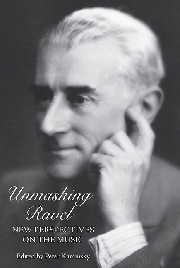Book contents
- Frontmatter
- Dedication
- Contents
- Acknowledgments
- Introduction
- Part One Orientations and Influences
- Part Two Analytical Case Studies
- 4 Ravel's Approach to Formal Process: Comparisons and Contexts
- 5 Repetition as Musical Motion in Ravel's Piano Writing
- 6 Playing with Models: Sonata Form in Ravel's String Quartet and Piano Trio
- 7 Spiral and Self-Destruction in Ravel's La valse
- 8 Diatonic Expansion and Chromatic Compression in Maurice Ravel's Sonate pour violon et violoncelle
- Part Three Interdisciplinary Perspectives
- List of Contributors
- Index
6 - Playing with Models: Sonata Form in Ravel's String Quartet and Piano Trio
from Part Two - Analytical Case Studies
Published online by Cambridge University Press: 05 September 2013
- Frontmatter
- Dedication
- Contents
- Acknowledgments
- Introduction
- Part One Orientations and Influences
- Part Two Analytical Case Studies
- 4 Ravel's Approach to Formal Process: Comparisons and Contexts
- 5 Repetition as Musical Motion in Ravel's Piano Writing
- 6 Playing with Models: Sonata Form in Ravel's String Quartet and Piano Trio
- 7 Spiral and Self-Destruction in Ravel's La valse
- 8 Diatonic Expansion and Chromatic Compression in Maurice Ravel's Sonate pour violon et violoncelle
- Part Three Interdisciplinary Perspectives
- List of Contributors
- Index
Summary
If you have something to say, this something will never emerge more distinctly than in your unintended unfaithfulness to a model.
Introduction
Ravel's advice to his students quoted above points to the central role that models played in his composing. A composer arguably with little overt “anxiety of influence,” Ravel sought inspiration both in past conventions and in the innovations of his contemporaries. Ravel's appropriation of baroque and classical forms implies both homage and provocation: playing with models, Ravel entices his listeners to place his creations in the lineage of the composers whose heritage he evokes while at the same time distancing himself from them. Jankélévitch's assertion that “every composition by Ravel represents … a certain problem to be solved” applies especially to works that are in sonata form: each presents a unique response to formal, harmonic, and motivic conventions of sonata-form “principles”—from early binary designs like those of Scarlatti to classical prototypes derived from Mozart to third-related key schemes à la Chopin.
My aim in this essay is to show how Ravel adapts, manipulates, and even subverts sonata paradigms of the past. To do so I will examine the respective first movements of the String Quartet and the Piano Trio. Separated by about a decade, the two movements represent very different solutions in Ravel's engagement with the form. The analyses also shed light on compositional developments in Ravel's prewar style that led toward condensation of form; more sophisticated integration of motivic, harmonic, and formal substance; and increasingly complex interaction of diatonic and nondiatonic collections.
- Type
- Chapter
- Information
- Unmasking RavelNew Perspectives on the Music, pp. 143 - 179Publisher: Boydell & BrewerPrint publication year: 2011



